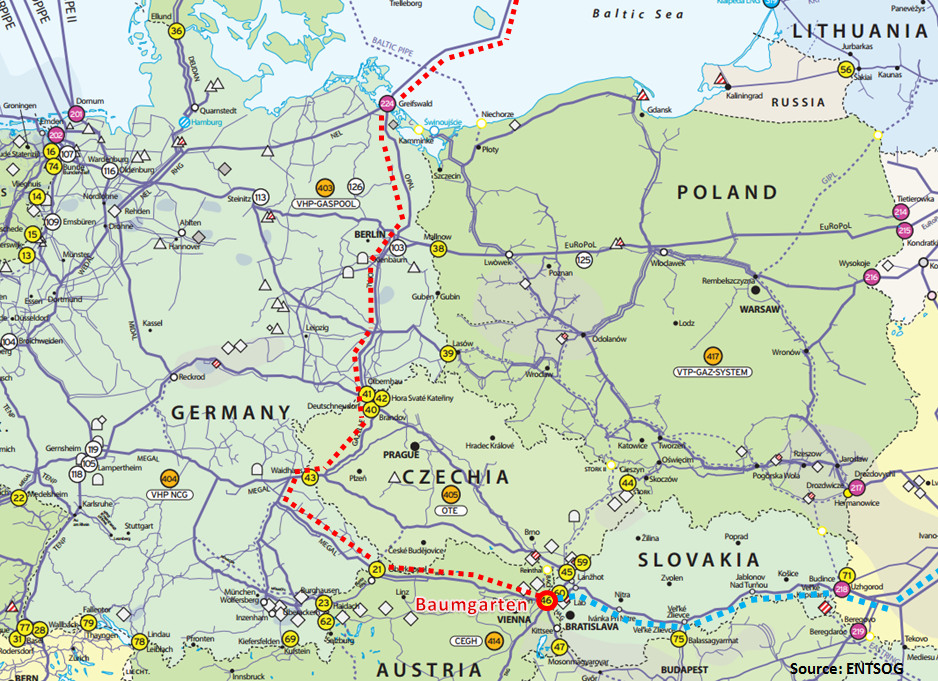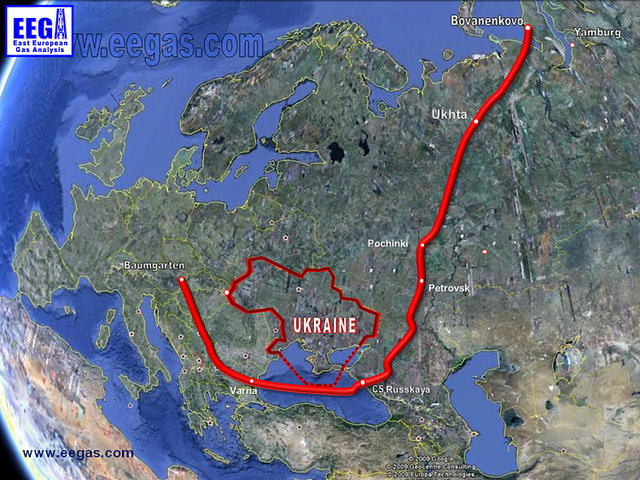|
In 2015, Ukrainian pipelines delivered
to the EU border
64.2 billion cubic meters (bcm) of Russian gas, including 37.8
bcm received by Slovakia. Most of the Slovakian flow went to the
Austrian terminal of Baumgarten.
Gazprom intends to replace the
pipeline route to Baumgarten via Slovakia by the one through
Nord Stream 2. According to
the company's press-release, Nord Stream 2 would help strengthen
Baumgarten's position as a key gas distribution center in Europe. In
fact, the Nord Stream route means additional transit fees and lower
profits of the shareholders of Gazprom.
Figure 1. Gas pipeline routes to
Baumgarten, Austria

In 2015, Gazprom paid for the gas
transit services of Nord Stream AG
Rub 73,966 Million or $1,219 Million. Nord Stream AG shipped
39.1 bcm of gas, so the transportation
cost can be calculated at $31.2 per thousand cubic meters (mcm).
According to
Alexey
Miller, "the current rate for gas transit via Ukraine is USD
2.5 for 1,000 cubic meters per 100 kilometers". Gazprom-Naftogaz
transit
contract specifies the gas transportation distance at 1240 km,
so the cost of Ukrainian transit is $31.0/mcm.
Therefore, Russian gas hits the EU
soil in Greifswald (Nord Stream outlet) at about the same cost as in
Velke Kapusany (border of Slovakia and Ukraine).
Figure 2. Transit fees outside of the
Russian territory

On the way from Ukraine to Baumgarten,
Russian gas has to cross Slovakia. As a matter of fact, Gazprom has
booked the capacity from Velke Kapusany to Baumgarten until 2029, so
the Russian company will have to pay for Slovakian transit even if
there is no gas in Slovakian pipelines.
"Surely, everyone here is concerned
about the future of gas contracts after the commissioning of the
Nord Stream and South Stream gas pipelines. May I assure you that
all commitments under these contracts shall be met. Commitments on
gas transit through Slovakia are secured by the “ship-or-pay”
condition. Therefore, you can be assured that your country will not
be left without transit fees", - deputy head of Gazprom
Alexander Medvedev said.
Following the route from Greifswald to
Baumgarten, Russian gas needs to be pumped through OPAL (Ostsee-Pipeline-Anbindungsleitung,
Germany), Gazelle (Czech Republic), MEGAL (Mittel-Europäische-Gasleitung,
Germany) and WAG (West-Austria-Gasleitung, Austria) pipelines. Gas
flow can take alternative route through Czech pipelines to Lanzhot.
Compared to the Ukrainian route, the
one through Nord Stream 2 requires additional capacity tariffs to be
deducted from the price of Russian gas in Baumgarten. On top of
that, Nord Stream 2 needs new gas pipelines to evacuate gas from
Greifswald (OPAL-2).
Figure 3. "The best route" to
Baumgarten

In June 2015,
Mr. Miller said that the best pipeline route to Baumgarten is
the one that runs across the Black Sea. Considering the improvement
of Russia's relations with Turkey, it looks like the Black Sea route
is better than the Baltic one now.
Mikhail
Korchemkin
East
European Gas Analysis
Malvern,
PA, USA
August 1, 2016
If you have found this information useful,
please consider making a donation.
|